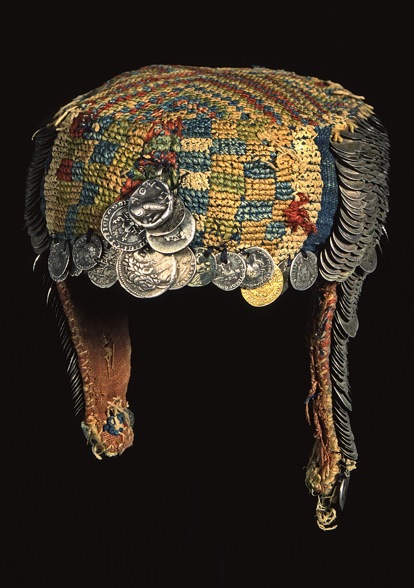Bride's money hat
Bethlehem, Palestine, c. 1845
 Collected by Charles Warren in 1870 and donated by Mrs Watkin Williams in 1952; 1952.5.86A bride would have worn this cap underneath her veil on the first day of a three-day wedding ceremony. In a tradition that continues to this day, she is carried in a parade to the groom's home, where the celebration takes place with food, sweets, music and dancing.
Collected by Charles Warren in 1870 and donated by Mrs Watkin Williams in 1952; 1952.5.86A bride would have worn this cap underneath her veil on the first day of a three-day wedding ceremony. In a tradition that continues to this day, she is carried in a parade to the groom's home, where the celebration takes place with food, sweets, music and dancing.
This cap incorporates both ancient and more recent coins. Its comparatively high frequency of coins minted in 1844 suggests that it was manufactured in the mid-1840s. There are more than 1600 Turkish Ottoman coins (paras) attached to the sides, dating to the reigns of the Sultans of the 17th century onwards. Along the forehead and across the back are approximately fifty more valuable coins of gold and silver ranging from Greek, Roman, Byzantine, Crusader, Italian, Hungarian, Polish, Danish to Spanish coins from the 16th–18th centuries or even earlier. There are also some Islamic coins dating back to AD 708.
Known locally as wuqayat al durahem, this 'money hat' was collected by General Sir Charles Warren, a knight of Justice of the Knights of St John of Jerusalem during his participation of archaeological explorations of the area in 1870. Coin headdresses found throughout North Africa and Middle East but the distinctively colourful woollen embroidery on this example signifies the area that the groom lives, thought to be around the western foothills of the Hebron Hills (Judean Mountains) area near Bethlehem and the border of the Palestinian-controlled West Banks territory and Israel. Hats like this were made and owned by individual family groups, hired out to other groups when a woman was to be married, and returned afterwards filled with sweets as a gesture of thanks.
Other similar headdresses worn by married women in this area and for example, in Pakistan, are covered in coins given by the groom and his family as part of the brideprice, reflecting both intrinsic monetary value and the 'value' of the bride. This money hat, however, had little monetary value but instead had great symbolic and decorative value. Certainly, the use of metal elements to provide a complementary sound element to a visually appealing object may be part of the reason behind the substantial re-use of coins in clothing and jewellery around the world. Even some of the coins on this headdress show signs of previous ornamental use suggesting their importance and function as a recyclable commodity. More recent examples incorporate coloured glass and plastic beads. However, as something of a rural tradition, the wearing of money hats is declining as people increasingly move to urban areas.
